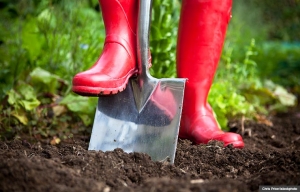Getting your Garden Ready for Spring

It’s been a long cold winter and we know that you are itching to get outside and into the garden. As soon as the snow melts it’s time to start some basic clean up that will ensure that your garden gets started on the right stem!
Get planning
If you’ve been turning the pages of garden catalogues over the winter months, with a cup of hot cocoa in hand and garden journal in your lap, you may already have TONS of ideas for this year’s garden. There are a lot of folks however who are just starting to dream up the wonderful flowers, trees and shrubs that could grace their Eden. Whatever type of gardener you are, planning is critical to a successful garden, so get to it! Think seasonally, what do you want to see in the Spring, Summer or Fall? Draw it out to scale and think of the size and spread of existing plants or garden features and consider anything you might like to add. If you aren’t a garden planning guru that’s no problem! Our amazing staff can help you plan the garden of your dreams, within your dream budget. Ask at front desk to speak to one of our helpful representatives or email us at info@totalitmanagement.ca.
Take Stock
Are all your tools in order? Sharpened? Need replacing? Has that mower of yours been serviced recently? If you need anything new start purchasing now! Nothing is worse than getting into a job and realizing you are without the proper equipment.
Garden Clean Up
The first task is removing and composting any dead annual plants that remained over winter. If there are some perennials that were un-pruned over the winter now is the time to give these guys their first good haircut. Most herbaceous perennials will by nature die back to ground level over a cold winter season. Once you start to see some new growth around the base you can safely prune down to the level just above this growth. Clean out any old mulch, twigs or whatever else Mother Nature has deposited in your garden over the season. Some of the shrubbier plants with woody stems such as sagebrush, or lavender need to be cut back each Spring, because they will only bloom on new branches. Once the branches are trimmed back it encourages the plant to send out new flowering branches into the world! Word of caution, wait until the danger of a hard frost has passed but before they start showing signs of opening buds on the lower stem or growth at the base. Clean up and discard debris as it may contain pathogens that overwinter.
Ornamental Grasses
Many ornamental grasses are left standing for a bit of visual interest over the cold months but now it’s time to chop the buggers down! You don’t need to wait for new growth. Cut grasses to within a few inches of the ground. Don’t feel bad about it; they’ll come back when they’re good and ready. A good way to limit mess when trimming grass is to tie garden twine (or any old string) around the fronds midway up, like a bushel, and then snip below.
Trees & Fruit Trees
When it comes to fruit trees, bushes or vines, it is important to remember that these plants only fruit on new wood. Constantly renewing that wood by annual pruning is a must for continued production and to maintain the quality and health of both the plant and the fruit. However do not prune early bloomers until after bloom. For example, Forsythia, Magnolia, Rhododendron. There are many types and styles of pruning. If you don’t have experience in this field, you will drive yourself nuts trying to learn an art form like this online. Trees, bushes and vines all require a different style of pruning and it would be difficult to list them all in this short space. Trees need to be opened up to allow air circulation. Bushes like raspberries need to be pruned back to a few inches from the ground every year. Grape vines require the removal of about 90 percent of their vegetative growth. Ridgeview Garden Centre has a tremendous amount of experience in this field, as along with being a full service garden centre, they also grow over 50 acres of fruit right here in Niagara. Stop in with any of your questions and they will be happy to help you out.
Fertilizer
Fertilizing in the Spring is important for a lot of reasons especially since you are likely turning the soil for the first time and it needs a little wake up, your garden’s cup of morning Joe. You’re likely getting ready to plant some Summer bulbs and Spring colour annuals so your soil needs a strong start. Get your plants off and running with a good flower garden fertilizer such as a 10-20-20 NPK fertilizer(Nitrogen, Phosphorous, and K, Potassium).
If you’ve been a good little composter and have some at your disposal (ha ha) it is also a good time to begin to spread this fertile blend into your little slice of heaven.
Happy Gardening!

